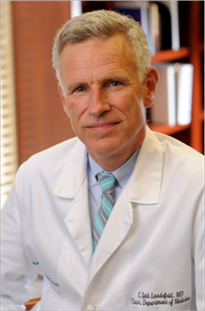 By Seth Landefeld, M.D.
By Seth Landefeld, M.D.Welcome back to Letters to Tinsley.
With this issue we celebrate our graduating class and our current Chief Residents – DJ Daly, Mallika Mundkur, Brita Roy, and Win Williams – and we welcome our next class of interns and the Chiefs of 2013-14 –Trey Clark, Sam McElwee, Chris Roth, and Amanda Vick.
I had two exceptional experiences since last writing you that I wish to share with you, my first weeks attending on our Tinsley Harrison Service and the 25th Anniversary of the Alabama Chief Residents Society. But before telling you those stories, I want to thank DJ, Mallika, Brita, and Win for an extraordinary year. My first 8 months have flown by as they introduced me to our housestaff and wards and showed me the ways of morning report without letting me stumble too often. And they brought the most delightful joy and intelligence to teaching, to caring, and to leading our training program. And we all owe special thanks to Mallika, the Founding Force to whom we owe these Letters to Tinsley.
And what a training program it is! In January, I attended on the Tinsley Harrison Service at University Hospital for the first time. I loved it, and I am sure that all of you who trained there remember why. I finished my weeks proud that we provide exemplary care to very sick people in great need, and I was delighted to see how much our housestaff are learning in an excellent environment.
For those of us who trained even a few years ago, the rhythm of the inpatient wards has changed. In response to work-hour regulations, our team (that hasn’t changed – a senior resident, two interns, and two 3rd-year medical students) admitted 12 patients every 5 days, 8 patients on long call and 4 patients short call, and none of the team spent the night in the hospital. Not that the days were short – we were sometimes in the hospital till midnight and back by 7am.
Other things haven’t changed, though – each patient provided extraordinary opportunities for doctoring and learning, and we did plenty of both. We rounded daily at the bedside and we found time almost every day to sit down together for 15-30 minutes to review a topic or a paper about one of our patients.
Over half a month we cared for 40 patients with an extraordinary variety of illnesses and needs. We cared for a woman with pyelonephritis that turned out to be more resistant to antibiotics than expected. When she developed recurrent sweats and chills just before she was scheduled to go home, we learned to take her symptoms seriously: she had recurrent bacteremia and would not have done well at home, even though she “looked good” and had received the usual course of IV antibiotics. A middle-aged woman was transferred to our service from a neighboring state because she couldn’t get out of bed and carried a diagnosis of Addison’s disease. She had profound postural hypotension and cerebellar ataxia with a normal cosyntropin stimulation test. We established a diagnosis of multisystem atrophy of the rare cerebellar type and discussed the diagnosis and its grim prognosis with our patient and her family, and we arranged for her to receive care at UAB’s Spain Rehabilitation Center, where she was able to learn to use an electric scooter that would keep her independent on going home. Our patient and her family greatly appreciated having things sorted out even though we could not offer cure. And then there was the young woman we admitted with neurocysticercosis, and the older woman with newly diagnosed HIV, and …. For each patient that month, our housestaff and students made a big difference, and we learned so much together.
Last month, I enjoyed the 25th Annual Meeting of the Alabama Chief Residents Society, which kindly inducted me as an honorary member. More than 50 of your “Chiefs” were back, led by the inveterate Mike Saag and Vincent Tuminello, who founded the Society in 1988, and by Lisa Willett, the Society’s current President. The special treats were listening to Glenn Cobbs and George Karam, who together taught me far more of Tinsley Harrison than I learned as a medical student buried in the baby blue edition. I learned Dr. Harrison’s ideas on the three roots of our profession – science and art, and that which few speak of, the priesthood of medicine. Glenn Cobbs told us of Dr. Harrison’s advice to “think like an engineer and feel like a minister.” And we heard about “contagious fire.” Contagious fire is the characteristic that epitomizes the great chief resident; it inflames the passions of others for caring and learning. I can only imagine how Tinsley Harrison himself must have burned with this fire.
Between attending on the Tinsley Harrison Service, celebrating our residents, and learning some of the richness of our Department’s history, I feel baptized in UAB’s waters. I hope many of you will return to visit us in the Department and to tell me of your experiences and how they shaped you. I look forward to meeting you on your next visit.